
Improved clinical efficiency and quality How can medtech meet physicians' digital technology needs?
15 minute read
24 September 2020
- Doug Billings United States
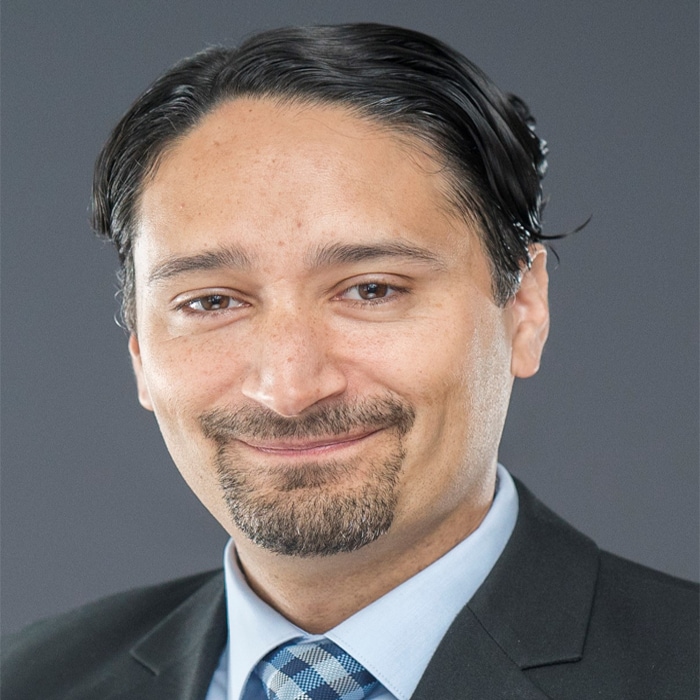 Felix Matthews, MD, MBA United States
Felix Matthews, MD, MBA United States Leena Gupta United States
Leena Gupta United States Debanshu Mukherjee United States
Debanshu Mukherjee United States
With physicians expecting the use of digital technologies in care delivery to grow in the next five years, medtech manufacturers have an untapped opportunity to team with them in driving clinical efficiency and care quality.
Executive summary
For many years, medical technology innovation held the promise of transforming care delivery, for example, through minimally invasive procedures, remote diagnostics and patient monitoring, and new mechanisms of increasing patient engagement and physician interactions. But adoption of virtual health was tepid until the COVID-19 pandemic finally broke down many of the barriers. The rapid rollout of virtual health in response to the outbreak offers some useful lessons on the physician adoption of digital technologies.
Learn more
Explore the life sciences collection
Learn about Deloitte’s services
Go straight to smart. Get the Deloitte Insights app.
In this article, we discuss findings from the Deloitte 2020 Survey of US Physicians and present their perspectives on novel digital technologies, such as artificial intelligence (AI) and automation. We believe readers will find the results valuable, both now and in the postpandemic environment.
Our research found that physicians are enthusiastic about what the medtech industry will offer but have questions about whether it will meet their biggest needs, which are:
- Interoperability: Eighty-four percent of physicians anticipate secure and efficient sharing of patient data and 83% believe that patient-generated data will be integrated into care delivery in the next 5–10 years.
- Optimized workflow: Sixty-one percent of physicians said their greatest need today is improving routine processes in the clinical practice.
- Intelligent augmentation: Sixty-four percent of physicians anticipate AI will help predict and diagnose diseases as well as prevent acute events and 54% expect routine medical images will be read and interpreted by machines.
- Data security and integrity: Physicians are open to technology adoption but have questions about safety and security. Sixty-nine percent of physicians wanted to know who is liable when a medical error occurs in connection with using technology for care and 47% wondered about vulnerability to cyberattacks.
Medtech manufacturers have an untapped opportunity to team with physicians in driving clinical efficiency and care quality. Delivering products and services tailored to physicians’ top four needs can not only facilitate adoption but also heighten impact.
Introduction
Physicians are enthusiastic about the prospects associated with the medtech industry but have questions about whether it will meet their biggest need—improved efficiency in care delivery.
The Deloitte 2020 Survey of US Physicians asked respondents to specify which market trends will have the greatest impact on care delivery in the coming years (figure 1). (For further details on the survey, see sidebar, “Methodology”). The top three trends in their views are:
Trend 1—New payment models: In previously published research, we highlighted how new payment models have the potential to spur adoption of new medical technologies that reduce costs and/or improve outcomes.1 Sixty-four percent of physicians recognize changes in payment models as powerful drivers of care delivery transformation.
Trend 2—Care team evolution: Forty-one percent of physicians expect advanced practitioners (nurse practitioners, physician assistants) and care managers to assume more meaningful roles as integral members of the care team. Advances in medical technologies offer them the opportunity to drive major changes in care delivery. Using telehealth visits and remote monitoring, a nurse practitioner can manage a patient’s health journey independently. Escalation to a physician is practically effortless, as patient records flow seamlessly between providers.
Trend 3—Advances in information technology: Forty-one percent of physicians also expect the standard practice of care delivery to change in the future as a result of cloud computing, predictive analytics, AI, interoperability, and 5G/better connectivity. In fact, 50% of physicians surveyed expect a “great deal of change” or more in their specialty in the next 10 years. Even more expect to see interoperability (84%) and patient-generated data integrated with care delivery (83%) in the next 5–10 years. Meanwhile, new information technologies and intelligent augmentation can help improve daily workflow and contribute to the quality and safety of care. (See sidebar, “Artificial intelligence or intelligent augmentation?” for definition.)
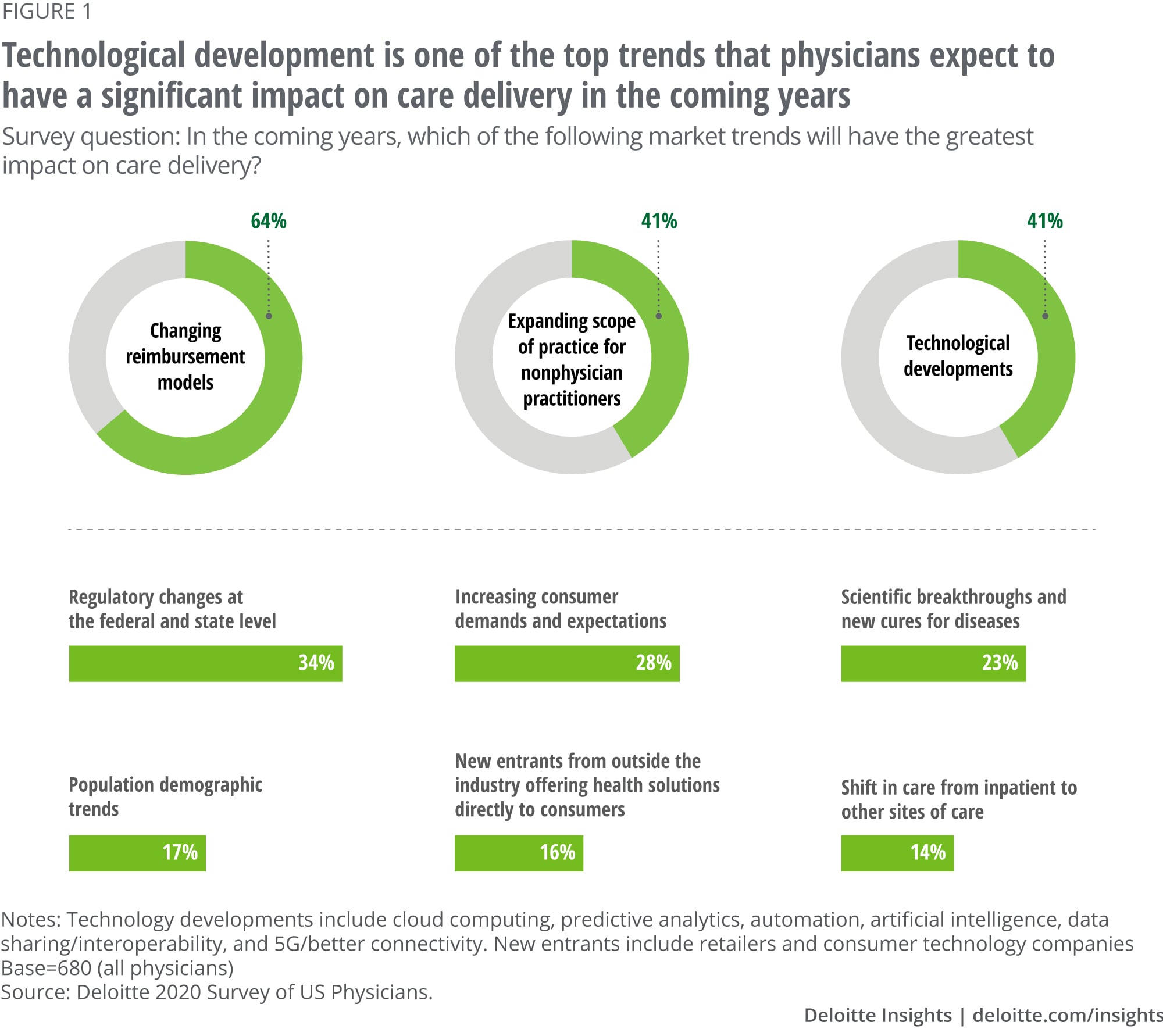
We acknowledge that these concepts are interdependent and that activities in one area can influence the others. For this article, we organized the survey findings into three sections:
- Interoperability
- Workflow optimization and intelligent augmentation
- Data security and integrity
Artificial intelligence or intelligent augmentation?
Our relationship with technology is evolving from simple automation to replace workers, to augmenting workers with technology, to collaboration between humans and machines.2 We envision that using technology for augmentation and collaboration can free up physician capacity for valuable activities that they enjoy and excel at, such as connecting with patients, showing compassion, and asking the right questions led by intuition and experience. This could be possible because effective augmentation and collaboration strategies use AI to reimagine the nature of the physician work.3 For these reasons, we favor the term intelligent augmentation.
Methodology
The Deloitte Center for Health Solutions fielded its biennial survey of US physicians from January 15 to February 14, 2020. This survey of 680 physicians reflects the national distribution of physicians in terms of years in practice, gender, geography, practice type, and specialty. See Appendix for detailed information on the sample.
Interoperability is a key enabler in future care delivery for physicians
A majority of surveyed physicians (84%) anticipate secure and efficient sharing of patient data in the next 5–10 years, and 83% expect that patient-generated data4 will be integrated into care delivery. Many physicians (65%) also believe that mechanisms will be in place allowing consumers to own and control their personal health data (figure 2). They reported that other advances—such as AI, virtually conducted robotic surgery, or hospital-at-home—are less likely to see wide adoption in the same time frame; perhaps physicians view interoperability as an essential enabler for other innovations.
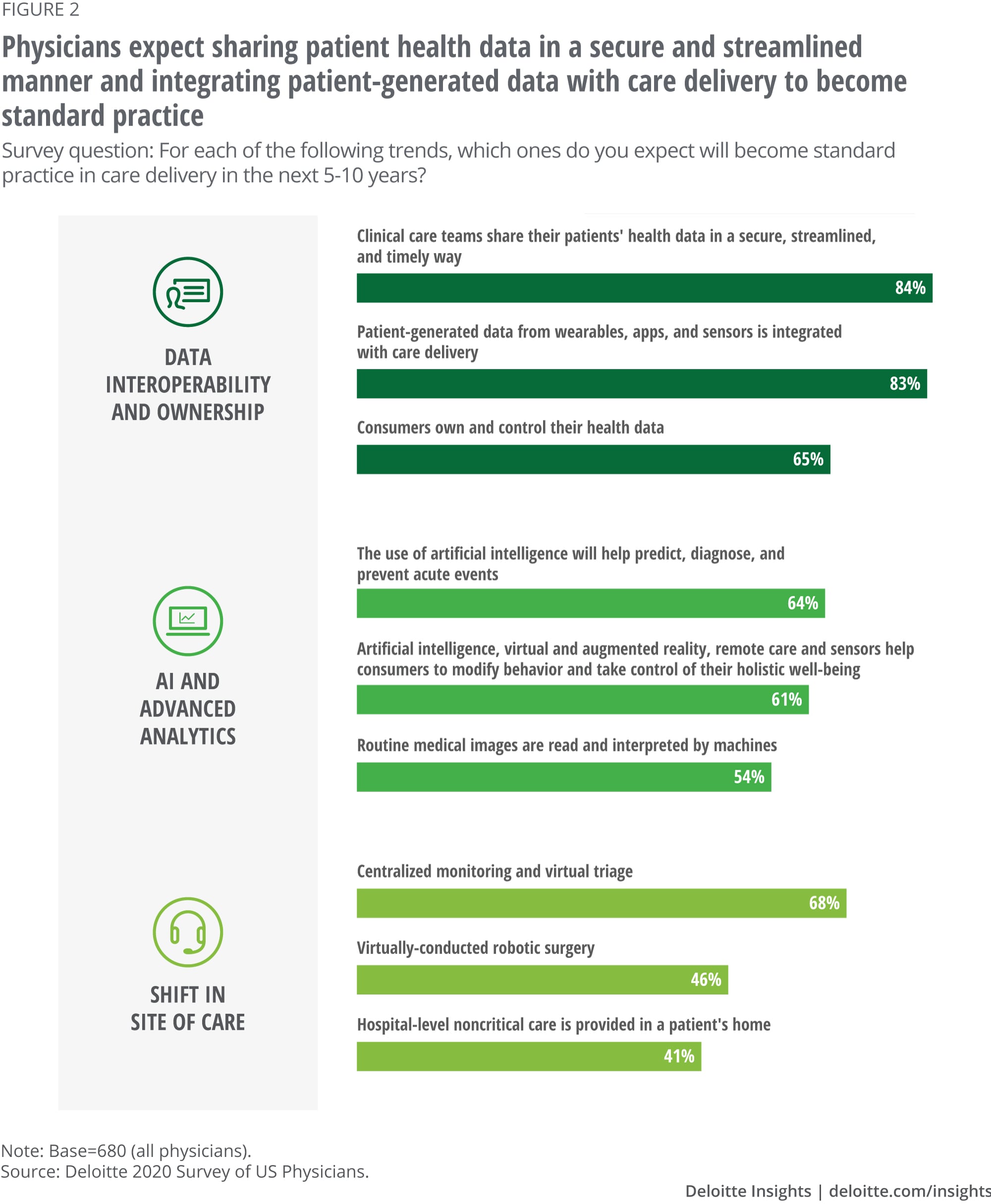
Optimized workflow and intelligent augmentation: Physicians want technologies that extend their reach and make care delivery easier
Building on a foundation of interoperability, physicians expect advanced technologies to revolutionize health care delivery—both in terms of better processes and better outcomes. Physicians are overburdened and want relief from some of their workload. A 2020 Medscape survey of physicians found that 42% are burned out; 55% reported administrative burden as their No. 1 reason for burnout.5 In our survey, 61% of the physicians said their greatest need is improving the processes in their daily clinical practice. Seventy-three percent said that advanced technologies such as AI and robotic process automation could save significant time and resources, while 49% said they could increase job satisfaction.
First, physicians in our survey say that many aspects of health care can be furnished away from today’s care settings with the help of advanced technologies. Sixty-eight percent of physicians across specialties expect centralized monitoring and virtual triage to become standard practice in the next 5–10 years (figure 2). Such shifts in care setting, when implemented in a way that connects with clinical workflow and takes advantage of improved analytics, have the potential to significantly reduce physicians’ nonproductive time, thus directly catering to their efficiency objective. However, we saw less consensus by specialty; PCPs were more likely to expect adoption of technologies that can support remote care:
- Fifty-five percent of PCPs versus 44% of specialists and 42% of surgeons predict virtually conducted robotic surgery could become standard practice.
- One in two PCPs (49%), 42% of specialists, and only 31% of surgeons expect hospital-at-home to become common.
Second, just over half (54%) of surveyed physicians expect machines will read and interpret routine medical images despite some uncertainty in the technology relative to the others mentioned. However, 64% expect AI will help predict and diagnose disease as well as prevent acute events. At the very least, 61% believe that AI, along with augmented and virtual reality, sensors, and remote care, will help consumers modify their behaviors and take control of their personal well-being (figure 2).
Third, when presented with specific use cases for their practice, our survey respondents were most interested in solutions related to documentation. This is consistent with physicians, regardless of specialty, looking to information technology to alleviate the pain of time-consuming, non-value-add tasks (figure 3). In fact, administrative processes are ripe for automation.6 Many physicians consider solutions related to EHR data entry to be extremely valuable--voice-to-text translation (48%), smart devices that auto-link to the patient record (48%), and technology-enabled patient intake and triage (40%).
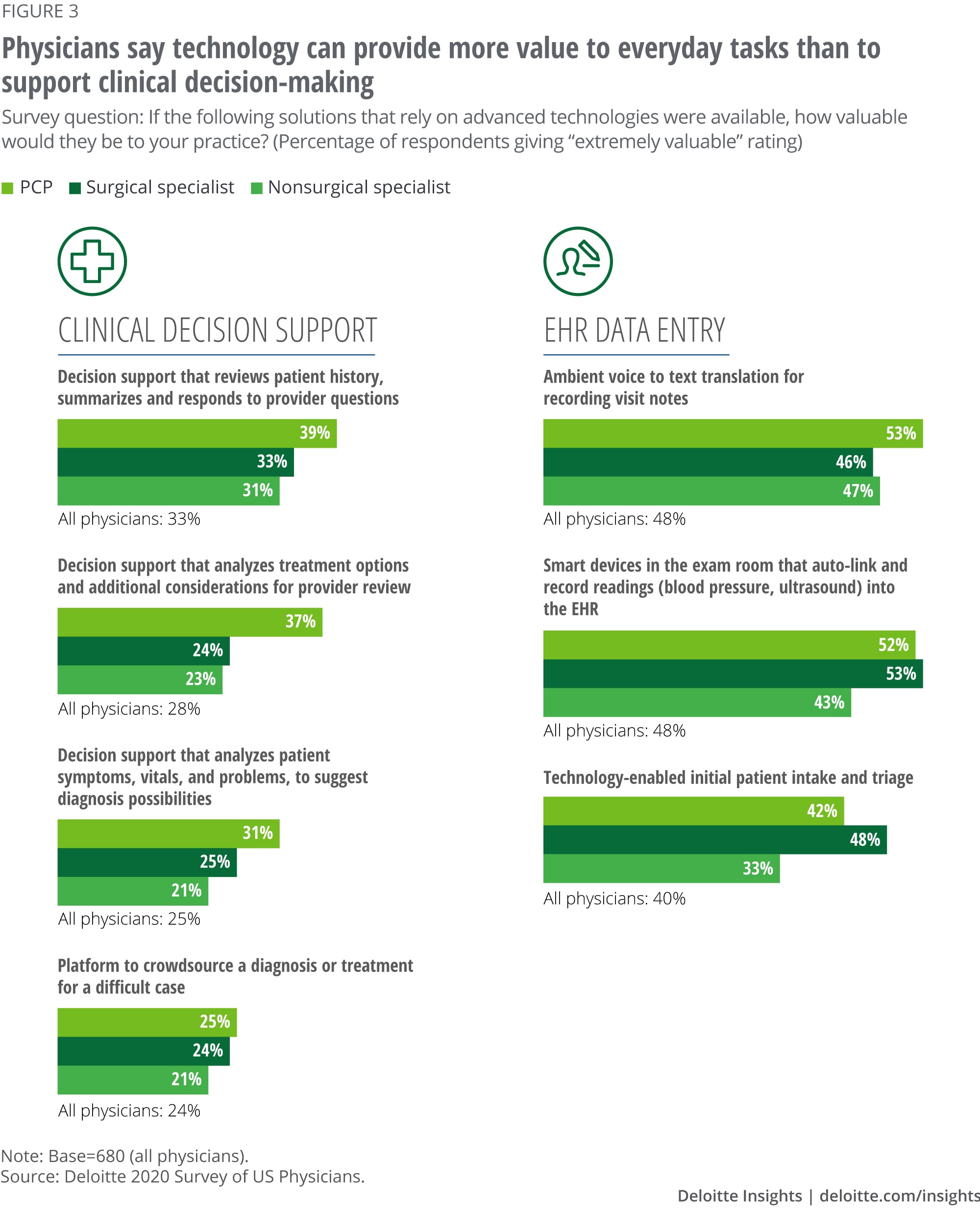
Lastly, when it comes to clinical decision support, physicians express less enthusiasm (figure 3). This said, PCPs place a higher value on tools assisting with diagnosis and treatment options, compared to surgeons and other specialists. Possibly, PCPs are more open to these solutions due to the breadth of knowledge required for a differential diagnosis workup. The inference is that PCPs see added value in AI solutions that can help them test for less common diagnoses, assist in cross-checking for gaps in care, and flag possible omissions in the treatment plan. By contrast, proceduralists may be more hesitant to entrust the clinical decision process, which may ultimately lead up to surgical intervention, to automated systems.
Survey results overall indicate that physicians expect medical innovation to meaningfully change their work, though this varies by use case and by specialty (figure 4). Physicians of all specialties (43%) and PCPs especially (71%) said that the advent of at-home diagnostics will have the greatest impact on their work or specialty. Physicians across specialties responded that the advent of at-home diagnostics will have the greatest impact on their work or specialty (43%). Cholesterol test kits, for example, can track triglyceride levels and allow patients to monitor outside of annual checkups. Advanced diagnostics could eliminate the need for in-person visits to a doctor’s office or lab, such as in-home rapid tests and remote examinations (e.g., EyeNetra and Butterfly iQ), or perhaps reduce the need for specialist referrals.
Forty-three percent of physicians expect the advent of at-home diagnostics to have the greatest impact on their work or specialty.
Surgeons reported most of the change in their specialty will come from miniaturization of medical devices (48%) and AR/VR technologies (47%). Existing examples of AR/VR technologies offer us a glimpse into the future. Assistive head-mounted devices, such as the HoloLens and Magic Leap, that help surgeons visualize the anatomy inside a patient during minimally invasive surgery, highlight the potential of AR/VR technologies in transforming surgeries.7
For many medtech manufacturers, proceduralists and surgeons are key customers for surgical tools and implantable devices. Our survey offers interesting insights about these customers. While younger and less-tenured physicians are commonly believed to be more open to technology adoption and more interested in technology advances, survey findings suggest that surgeons of all experience levels are equally likely to show an interest in new technologies, including AI and those that support the shift in site of care, such as hospital at home. Moreover, while we did not find a correlation between years of experience and openness to several types of technological developments, younger surgeons were significantly more likely to express skepticism of virtually conducted robotic surgery than those with more experience.
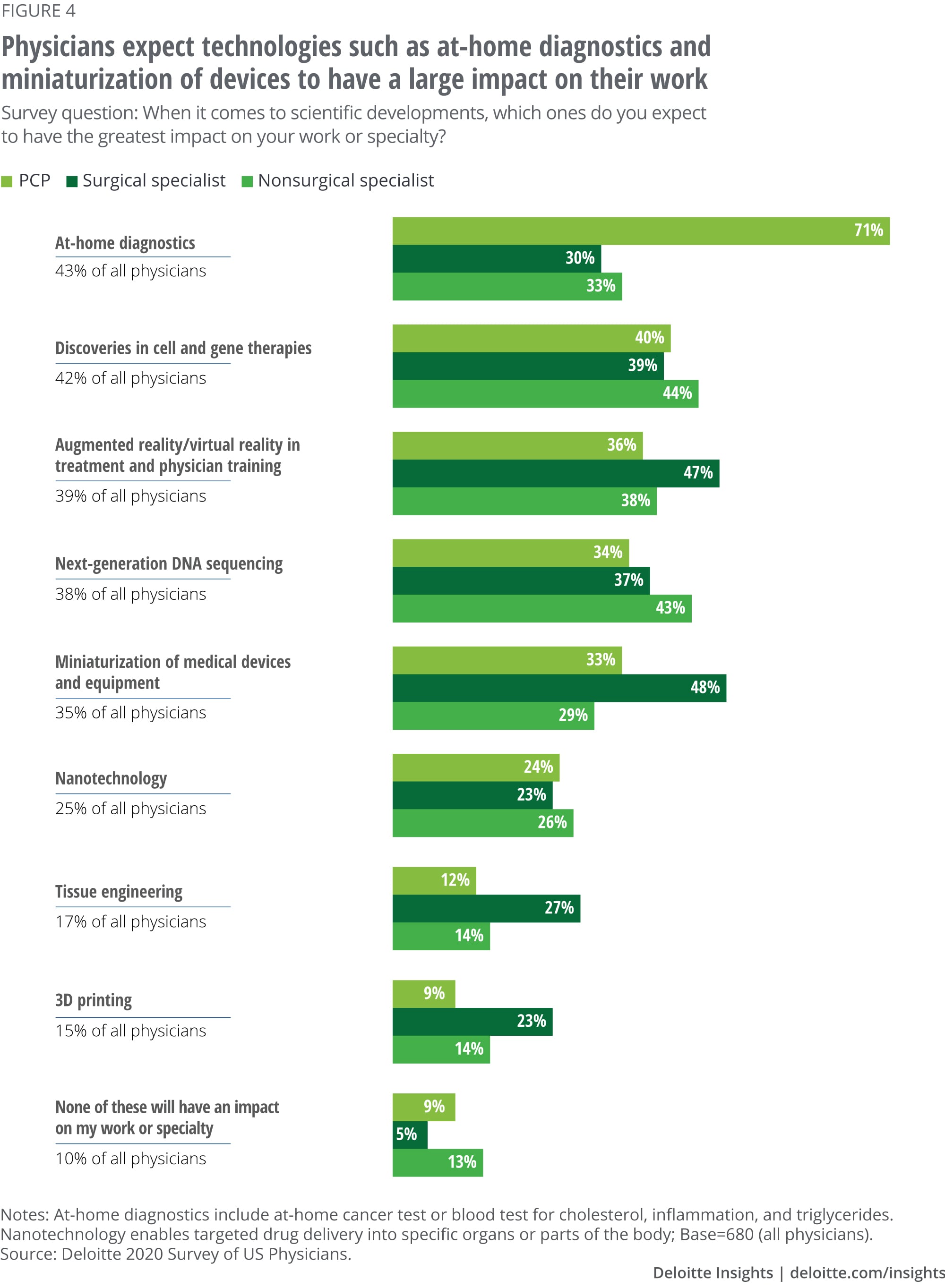
Data security and algorithm integrity: Technology generates interest among physicians but data security concerns remain
Despite the desire for technologies to improve both workflow and patient outcomes, our respondents expressed concern over cost and liability for solutions that take over part of their jobs. For example, 69% wanted to know who is liable when a medical error occurs in connection with using technology for care and 47% wondered about vulnerability to cyberattacks (figure 5). Questions about the validity and reliability of algorithms were raised by 45% of respondents. These are known concerns shared by others in the industry.8 One way to find answers to these questions would be for medtech to consider partnering with providers, regulators, and patient groups.
Sixty-nine percent of physicians want to know who is liable when a medical error occurs in connection with using technology for care and 47% wondered about vulnerability to cyberattacks.

The survey, which was conducted just before the COVID-19 pandemic, showed that almost 90% of the time, conditions that physicians deemed to be essential to adopting virtual health technologies were absent in their practices.9 Since then, many barriers such as consumer demand, licensing and credentialing requirements, and payment have been removed, and useful lessons on physician adoption of digital technologies more broadly have come to light.
Before COVID-19 began, physicians said that conditions essential to adopting virtual health technologies were missing almost 90% of the time in their practices.
In fact, in a Deloitte survey of clinical leaders about resuming deferred elective procedures conducted in early May 2020, nearly all said their organizations have implemented (88%) or plan to implement (10%) virtual health practices for some or all nonprocedure visits.10 In a separate Deloitte survey of health system and health plan CFOs conducted in June 2020, health system CFOs identified virtual health technologies (93%) and cybersecurity (83%) as top strategic priorities, and achieving efficiencies through digitization (67%) as a top cost management initiative.11 As technology makers attempt to commercialize new products, they should consider the barriers that still exist and learn from the lessons of forced rapid adoption. They should also consider the factors that not only facilitate but also propel physicians to use advanced technologies that enable secure data flow, advanced analytics, and the shift in site of care. Here are a few ways medtech manufacturers can go about this:
- Interoperability is vital: Without interoperability, none of the promised benefits of new technological solutions can be realized. New information technologies should offer compelling and easy-to-use interfaces and must integrate seamlessly with existing EHR and clinical systems in a vendor-agnostic way. Failing to do so could force customers to look for homegrown or third-party plug-ins, increasing their costs, compromising data transfer, and diminishing the value of medtech products.
- Create value through optimized workflow: Physicians’ tolerance for poorly designed, difficult-to-use solutions that detract from patient interactions is waning. For example, fiddling around with a wearable device during the clinic visit to configure it or to download data is inefficient. While interoperability is a requirement for new digital tools, it is not sufficient on its own. Manufacturers should focus on how their products can create value for patients, providers, and payers. Human-centered design and process thinking rather than product-focused thinking can also help. Additionally, the data from improved products could in turn be used as evidence to drive the adoption of new risk-sharing payment models to help manufacturers get paid for their advanced solutions. For example, monitoring recovery velocity after a major surgery can help substantiate the value of using a more costly device or technique for the procedure.
- Intelligent augmentation over AI: Given physician interest in automating routine tasks for themselves and their staff, and expanding their reach through other health care professionals, medtech manufacturers should focus on products that automate some aspects of the work and augment existing skills rather than replace tasks that humans enjoy and are good at. New information technologies could help provide safeguards for mid-level professionals, such as decision support, as they take over some tasks currently dominated by physicians.
- Data security and integrity should be a top priority: Even though physicians are not directly responsible for information security and data quality as part of their work, they have many unanswered questions around cybersecurity and the integrity of the algorithms behind advanced technology solutions. Medtech manufacturers should ensure their products meet current cybersecurity requirements and offer assurances of continued ability to do so in the future. They should also transparently communicate how their algorithms work and ensure ongoing validation by academia, regulators, and independent third parties – for instance, demonstrating that consistent results can be achieved in the customer’s environment using that customer’s data and processes.
Additionally, we see a few other areas of opportunity for specific technology innovations that can enable better care delivery:
- Diagnostics: Physicians expect continued development and sophistication of diagnostic capabilities, with at-home diagnostics having an outsize impact on PCPs (figure 5). With the increasing use of technologies in health care, physicians expect greater use of diagnostics. For instance, our survey results suggest that the net effect of automation on physician work will be an increase in diagnostic tests: Thirty-six percent of physicians anticipate an increase, 13% expect a decrease, and 51% expect no change. Opportunities in diagnostics are further accentuated by a long-standing growth in chronic conditions, a renewed focus on infectious diseases as a result of COVID-19, and shifting priorities toward prevention. Advanced diagnostics that eliminate the need for in-person visits to a doctor’s office or lab, such as in-home rapid tests and remote examinations, are examples of innovations that should enable medtech to expand its footprint.
- Remote monitoring: Manufacturers already have a strong presence and credibility here. Particularly, when it comes to clinical grade and implantable smart devices (such as pacemakers, smart joints, and continuous biomarker measuring devices), providers rely on manufacturers for product performance and understanding the science behind the devices. The use of remote monitoring is expected to increase due in part to the COVID-19 pandemic but also as a result of changing payment models.
- Building the connected care ecosystem: In the longer term, we believe that medtech manufacturers have an opportunity to own the connected care continuum by building complete solutions for their customers. In Deloitte’s future of health vision, technologies such as AI, advanced diagnostics, and remote monitoring will likely shift care delivery away from traditional settings and play an important role in transforming health care. To preserve well-being and avert illness, providers may look for holistic care solutions that generate insights longitudinally for patients and populations from a variety of data sources, not just inputs from one device. For instance, a smart remote monitoring solution can create a personalized and adaptive treatment plan based on continuous measurements such as biometrics and environmental metrics and interval-based measurements such as patient-reported outcomes12 and social determinants of health.13
Conclusion
Physicians expect the use of digital technologies in care delivery to increase in the coming years. The medtech industry has a great opportunity to tailor their products based on their needs and accelerate their adoption.
Medtech’s customers are an increasingly evolving complex network. Physicians use the equipment bought and paid for by a health system or hospital, implantable devices are reimbursed by payers, and patients are the end users or recipients of an implant. Physicians seek significant clinical benefits, efficiency, and ease of use from new technologies. Buyers and payers want new products that reduce procedure time, length of stay (for inpatient), resource utilization, and post-op recovery time to spur adoption and provide evidence for payment.14 As customers’ goals and needs change, we believe medtech manufacturers should consider transforming their product lines, too. While scientific innovation is paramount, medtech manufacturers should consider other factors such as interoperability, workflow efficiency, and data security—which are key concerns for their customers—when designing new products. As health care continues to shift out of acute settings, manufacturers should bear in mind the lessons learned from rapid technology adoption during the COVID-19 pandemic, as well as physician concerns about liability, as demands for connected systems are being met and built.
Appendix
Methodology
Since 2011, the Deloitte Center for Health Solutions has been surveying a nationally representative sample of US physicians on their attitudes and perceptions about the current market trends impacting medicine and future state of the practice of medicine.
The general aim of the survey is to understand physician adoption and perception of key market trends of interest to the health care, life sciences, and government sectors. In 2020, 680 US primary care and specialty physicians were asked about a range of topics: future of work, future of health, virtual health, digital transformation, and value-based care.
The national sample is representative of the American Medical Association (AMA) Masterfile with respect to years in practice, gender, geography, practice type, and specialty to reflect the national distribution of US physicians.
Data collection took place between January 15 and February 14, 2020.
About the AMA
The AMA is the major association for US physicians and its Masterfile is a census of all US physicians (not just AMA members). The database contains records of more than 1.4 million US physicians and is based upon graduating medical school and specialty certification records. It is used for both state and federal credentialing, as well as for licensure purposes. This database is widely regarded as the gold standard for health policy work among primary care physicians and specialists, and is the source used by the federal government and academic researchers for survey studies among physicians. We selected a random sample of physician records with complete mailing information from the AMA Masterfile, and stratified it by physician specialty, to invite participation in an online 20-minute survey.
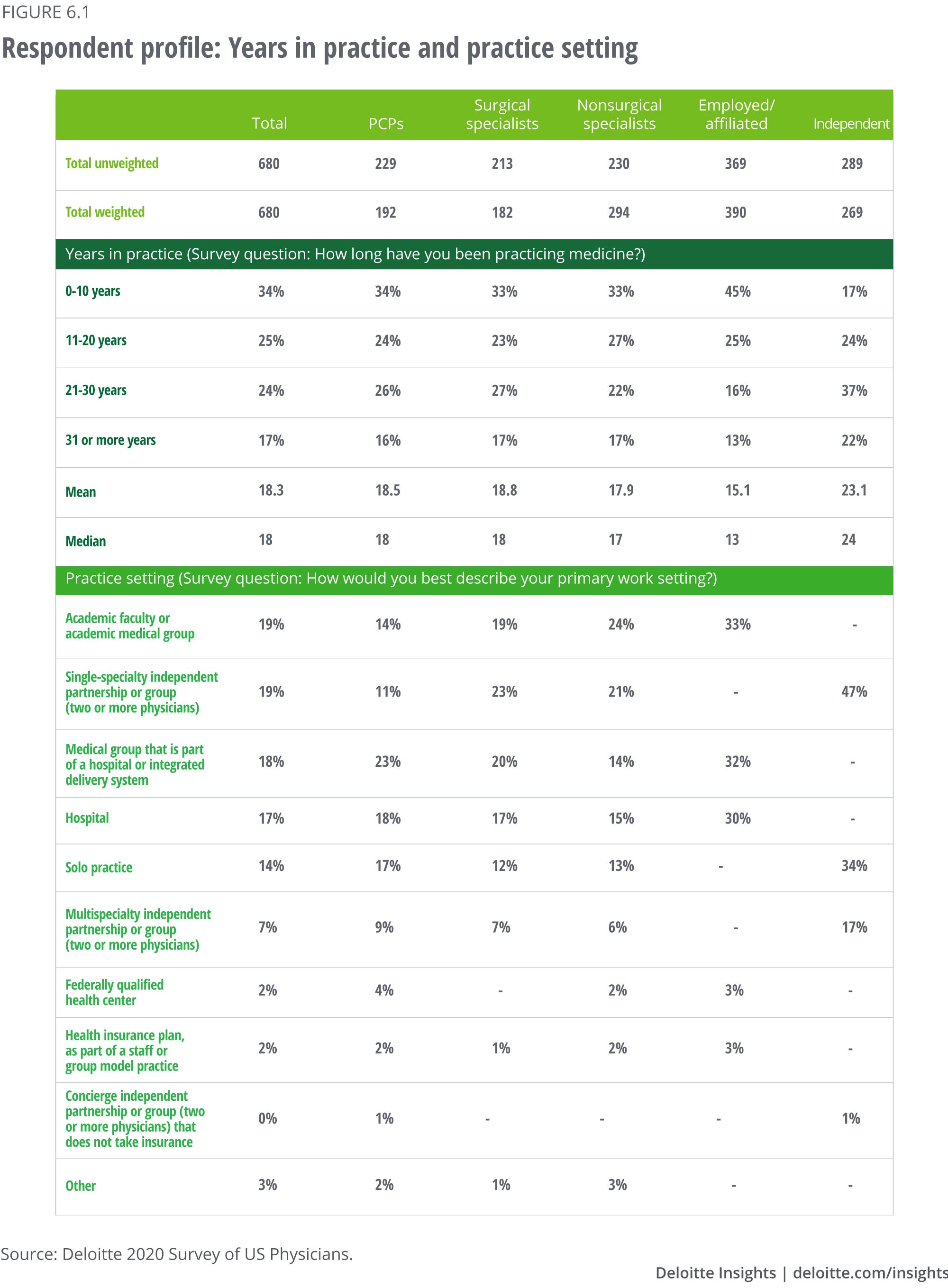
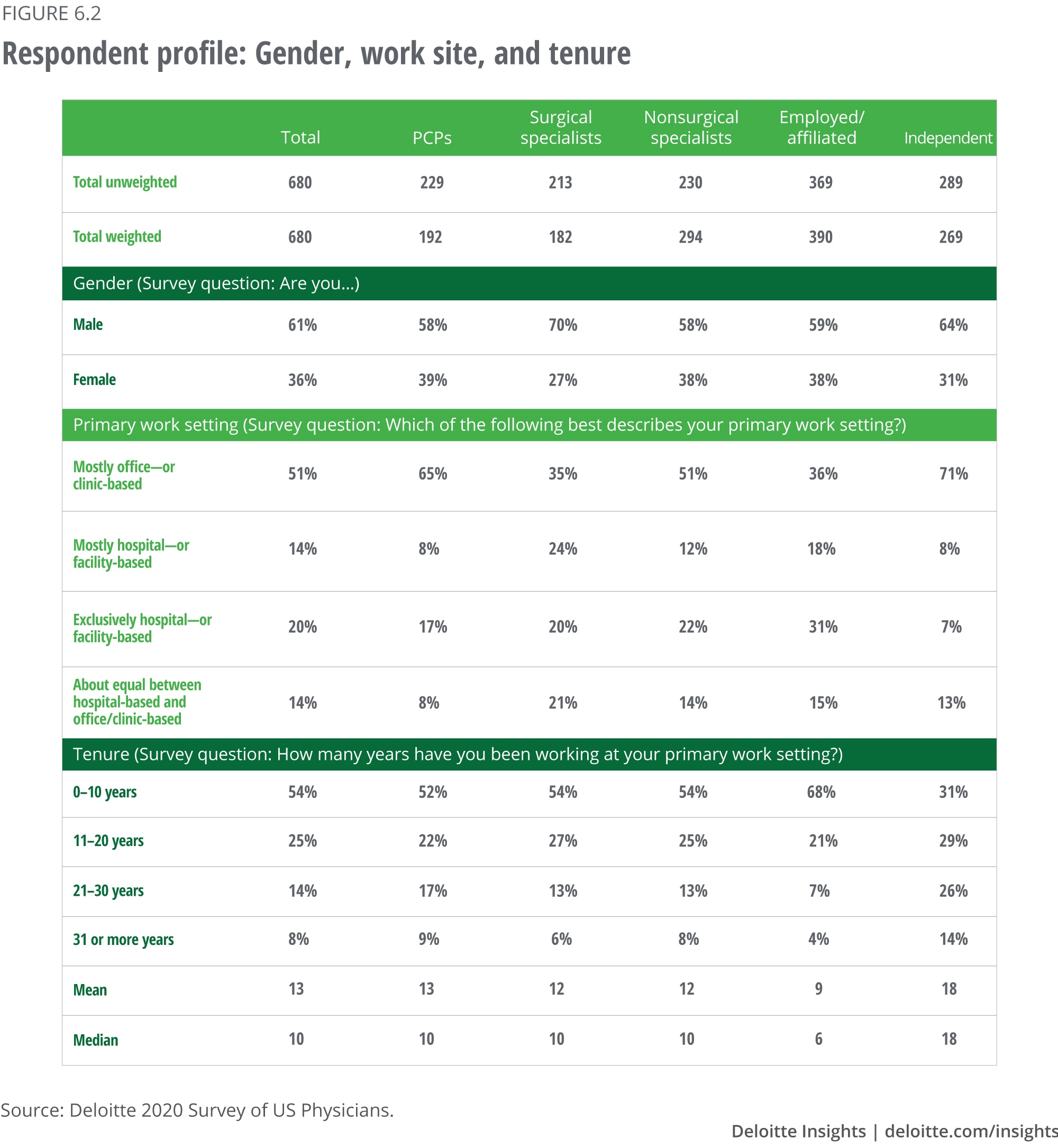
© 2021. See Terms of Use for more information.
More on medtech
-
The future of medtech Video4 years ago
-
Medtech leaders prioritize technology and consumers Article4 years ago
-
New payment models in medtech Article5 years ago
-
Radical interoperability Article5 years ago
-
Winning in the future of medtech Article5 years ago
-
Life Sciences Collection









